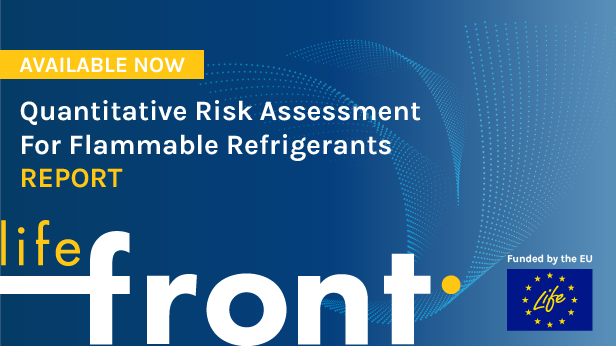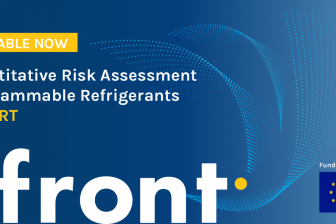Quantitative Risk Assessment of Flammable Refrigerants to Validate the Level of Safety of Proposed Mitigation Measures for Minimising Flammability Risk

The LIFE FRONT project has undertaken a risk assessment to fulfil its goal of removing barriers posed by standards for flammable refrigerants in RACHP applications.
Natural refrigerants, such as hydrocarbons (HCs), provide an important environmentally friendly alternative for the refrigeration, air conditioning and heat pump (RACHP) sector in the effort to reduce greenhouse gas (GHG) emissions. Interest in, and application of, HCs such as R290 is growing steadily as the global warming impact of refrigerants within the RACHP industry gains importance. This is particularly true within the context of the public discussion on climate change, relevant legislation, and climate targets set at international, EU, and national levels. However, it is important to keep in mind that HCs are flammable and may pose fire and explosion hazards, so if used in RACHP equipment, the likelihood and severity of the hazard should be minimised.
European legislation demands that products being introduced to the market should be “safe”. Companies need to comply with relevant health and safety directives before introducing any new products to the market. This requirement is inferred through compliance with relevant directives and/or safety standards. A qualitative and/or quantitative risk assessment provides tools to analyse potential risks, hazards and resulting consequences as well as to assess the potential effect of risk mitigation measures. It can thus demonstrate the level of safety of a product, which then can be gauged against other relevant hazards to determine the acceptability of a risk.
Risk assessments (RAs) provide a robust means of demonstrating the level of safety of a product. For a risk assessment, different techniques can be used including, for example, fault tree and event tree analysis, cause and consequence analysis, hazard analysis, and critical control points.
The LIFE FRONT project led such risk assessment to fulfil its goal to remove barriers posed by standards for flammable refrigerants in RACHP applications. It strives to improve system design to address flammability risks and encourage thereby wider uptake of climate-friendly alternatives to fluorinated gases.
“First, the project produced a detailed explanation and breakdown of relevant safety standards and associated barriers related to RACHP equipment,” explained Pauline Bruge, Project Coordinator in shecco’s Market Development team.“This is provided in the Impact of Standards on Hydrocarbon Refrigerants in Europe –Market research report. Also, a thorough field study on leaks in RACHP equipment and subsequent laboratory tests on gas concentration development and consequences were performed under the LIFE FRONT project.” The results are summarised in the report Recommended leak hole size and mass flow rate by system and application characteristics and in two databases: theRefrigerant Leak Size Database and the Concentration Database.
Building on lessons learned from the field study and laboratory tests, work then focused on improving product design by making modifications to current practice to accommodate for the use of larger HC charges and by evaluating options for passive and active risk mitigation measures. Tests were implemented on a prototype each of the industrial partners of the LIFE FRONT project: AHT, AiT and NIBE. Prototypes included a commercial refrigerating cabinet, an indoor packaged air-to-water heat pump, and a ground source heat pump derived from an existing catalogue product that had been specifically designed and modified to function with R290.
In the tests, the effectiveness of the specific design in mitigating the risk and preventing the creation of an uncontrolled explosive atmosphere was assessed and a robust and reliable methodology for evaluating the safe usage of a product using flammable refrigerants was defined. Results of this practical work were discussed in an internal project workshop on quantitative risk assessment.
The LIFE FRONT report summarising the results of the workshop provides an overview of relevant information on RAs for flammable refrigerants in Chapter one. Chapter two provides more concrete guidance for RACHP companies by presenting three exemplary RAs for products from the three industry partners using R290: a refrigerated display cabinet, a ground source heat pump and an air/water heat pump.
In general, based on the work under this project and also within the wider literature, it is seen that the flammability risk presented by the use of HCs is low compared to the fire risk associated with other comparable equipment and appliances. For instance, the example of the display cabinet described in the report illustrates that the flammability risk can be several times lower than the background or residual risks (such as from electrical fires, etc.). This also need to be taken into account when revising RACHP safety standards.
“Identified hazards for all three appliances (two heat pumps and a refrigerated cabinet) are analysed in this report, showing that these often arise from human errors or misbehaviour. Detailed and easy to understand instruction manuals and well-trained technical personal for installation, commissioning and decommissioning are consequently seen as effective mitigation measures to reduce identified risks. Hermetically-sealed leak-tight systems are also seen as essential to prevent the formation of an explosive atmosphere within and surrounding the appliance in case of a leak,” said Daniel Colbourne , Engineer at German Consulting Firm HEAT GmbH and Lead Technical Expert of the LIFE FRONT project.
Whilst training for safe handling of HCs is currently available in Europe, it is not consistent. – Apart from those under the ATEX Workplace directive, the demands to mandate it at a national level are vague. Raising awareness of this directive (especially its Annex II(A)) is recommended, since it was found in meetings of interest groups that the majority of stakeholders and practitioners seem to be largely unaware of it.
The report is available in the Downloads section together with complementary slides from the LIFE FRONT Workshop on Hydrocarbon Refrigerant Safety – Quantitative Risk Assessment on RACHP equipment study.






